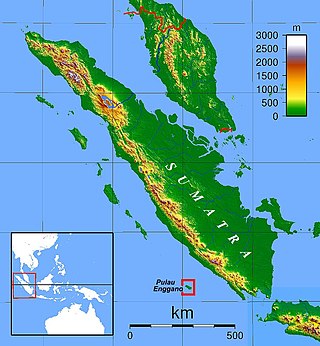Related Research Articles

Fijian is an Austronesian language of the Malayo-Polynesian family spoken by some 350,000–450,000 ethnic Fijians as a native language. The 2013 Constitution established Fijian as an official language of Fiji, along with English and Fiji Hindi and there is discussion about establishing it as the "national language". Fijian is a VOS language.
Taba is a Malayo-Polynesian language of the South Halmahera–West New Guinea group. It is spoken mostly on the islands of Makian, Kayoa and southern Halmahera in North Maluku province of Indonesia by about 20,000 people.
The Nafsan language, also known as South Efate or Erakor, is a Southern Oceanic language spoken on the island of Efate in central Vanuatu. As of 2005, there are approximately 6,000 speakers who live in coastal villages from Pango to Eton. The language's grammar has been studied by Nick Thieberger, who has produced a book of stories and a dictionary of the language.
Máku, also spelled Mako, and in the language itself Jukude, is an unclassified language and likely language isolate once spoken on the Brazil–Venezuela border in Roraima along the upper Uraricoera and lower Auari rivers, west of Boa Vista, by the Jukudeitse. 300 years ago, the Jukude territory was between the Padamo and Cunucunuma rivers to the southwest.
Manam is a Kairiru–Manam language spoken mainly on the volcanic Manam Island, northeast of New Guinea.
Roviana is a member of the North West Solomonic branch of Oceanic languages. It is spoken around Roviana and Vonavona lagoons at the north central New Georgia in the Solomon Islands. It has 10,000 first-language speakers and an additional 16,000 people mostly over 30 years old speak it as a second language. In the past, Roviana was widely used as a trade language and further used as a lingua franca, especially for church purposes in the Western Province, but now it is being replaced by the Solomon Islands Pijin. Published studies on Roviana include: Ray (1926), Waterhouse (1949) and Todd (1978) contain the syntax of Roviana. Corston-Oliver discuss ergativity in Roviana. Todd (2000) and Ross (1988) discuss the clause structure in Roviana. Schuelke (2020) discusses grammatical relations and syntactic ergativity in Roviana.
Ughele is an Oceanic language spoken by about 1200 people on Rendova Island, located in the Western Province of the Solomon Islands.
Biak, also known as Biak-Numfor, Noefoor, Mafoor, Mefoor, Nufoor, Mafoorsch, Myfoorsch and Noefoorsch, is an Austronesian language of the South Halmahera-West New Guinea subgroup of the Eastern Malayo-Polynesian languages.
Paamese, or Paama, is the language of the island of Paama in Northern Vanuatu. There is no indigenous term for the language; however linguists have adopted the term Paamese to refer to it. Both a grammar and a dictionary of Paamese have been produced by Terry Crowley.
Adang is a Papuan language spoken on the island of Alor in Indonesia. The language is agglutinative. The Hamap dialect is sometimes treated as a separate language; on the other hand, Kabola, which is sociolinguistically distinct, is sometimes included. Adang, Hamap, and Kabola are considered a dialect chain. Adang is endangered as fewer speakers raise their children in Adang, instead opting for Indonesian.
Uyghur is a Turkic language spoken mostly in the west of China.
Kei is an Austronesian language spoken in a small region of the Moluccas, a province of Indonesia.
Buru or Buruese is a Malayo-Polynesian language of the Central Maluku branch. In 1991 it was spoken by approximately 45,000 Buru people who live on the Indonesian island of Buru. It is also preserved in the Buru communities on Ambon and some other Maluku Islands, as well as in the Indonesian capital Jakarta and in the Netherlands.

The Enggano language, or Engganese, is an Austronesian language spoken on Enggano Island off the southwestern coast of Sumatra, Indonesia.
Mavea is an Oceanic language spoken on Mavea Island in Vanuatu, off the eastern coast of Espiritu Santo. It belongs to the North–Central Vanuatu linkage of Southern Oceanic. The total population of the island is approximately 172, with only 34 fluent speakers of the Mavea language reported in 2008.
Dom is a Trans–New Guinea language of the Eastern Group of the Chimbu family, spoken in the Gumine and Sinasina Districts of Chimbu Province and in some other isolated settlements in the western highlands of Papua New Guinea.
Neve’ei, also known as Vinmavis, is an Oceanic language of central Malekula, Vanuatu. There are around 500 primary speakers of Neve’ei and about 750 speakers in total.
Longgu (Logu) is a Southeast Solomonic language of Guadalcanal, but originally from Malaita.
Neverver (Nevwervwer), also known as Lingarak, is an Oceanic language. Neverver is spoken in Malampa Province, in central Malekula, Vanuatu. The names of the villages on Malekula Island where Neverver is spoken are Lingarakh and Limap.
Turkmen grammar is the grammar of the Turkmen language, whose dialectal variants are spoken in Turkmenistan, Iran, Afghanistan, Russia, China, Uzbekistan, Tajikistan and others. Turkmen grammar, as described in this article, is the grammar of standard Turkmen as spoken and written by Turkmen people in Turkmenistan.
References
- ↑ West Damar at Ethnologue (18th ed., 2015) (subscription required)
- ↑ Mark Taber. 1993. Toward a better understanding of the Indigenous Languages of Southwestern Maluku. Oceanic Linguistics 32. 389-441.
- ↑ Aone van Engelenhoven. 2010. Tentatively locating West-Damar among the languages of Southwest Maluku. In Chlenova, Svetlana and Fedorchuk, Artem (eds.), Studia Anthropologica: a Festschrift in Honor of Michael Chlenov, 297-326. Moscow-Jerusalem: Gesharim.
- 1 2 "West Damar Language or Damar-Batumerah, an Isolate in South-Eastern Indonesia" (PDF). 2015-05-12. Archived from the original (PDF) on 2015-05-12. Retrieved 2020-07-04.
- 1 2 Chlenova, Svetlana (2008). "Preliminary Grammatical Notes on Damar Batumerah or West Damar, a Language of Southwest Maluku". In Yury Lander; Alexander Ogloblin (eds.). Language and Text in the Austronesian World: Studies in honor of Ülo Sirk. München: Lincom. pp. 163–177.